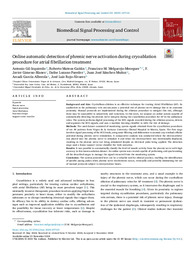Título :
Online automatic detection of phrenic nerve activation during cryoablation procedure for atrial fibrillation treatment |
Autor :
Gil Izquierdo, Antonio 
Mateos Gaitan, Roberto 
Melgarejo Meseguer, Francisco Manuel 
Gimeno Blanes, Francisco Javier
Lozano-Paredes, Dafne 
SANCHEZ MUÑOZ, JUAN JOSE 
García-Alberola, Arcadi 
Rojo-Álvarez, José Luis  |
Editor :
Elsevier |
Departamento:
Departamentos de la UMH::Ingeniería de Comunicaciones |
Fecha de publicación:
2025 |
URI :
https://hdl.handle.net/11000/37194 |
Resumen :
Background and Aim:
Cryoballoon ablation is an effective technique for treating Atrial Fibrillation (AF). Its application in the pulmonary vein antrum poses a potential risk of phrenic nerve damage due to its anatomic proximity. Manual protocols are implemented during the ablation procedure to mitigate this risk, although these may be susceptible to subjectivity and variations. In this work, we propose an online system capable of automatically detecting the phrenic nerve integrity during the cryoablation procedure for AF in the pulmonary veins. The system performs digital processing of the ECG signals recorded during the ablation process, detects and segments the ECG signals, and uses a machine learning classifier to infer the risk of damage.
Methods:
The used dataset consisted of monitoring system signals obtained from the cryoablation procedures of ten AF patients from Virgen de la Arrixaca University Clinical Hospital in Murcia, Spain. The first stage involves signal processing of the ECG leads, using noise filtering and delineation to unmask any residual cellular potential during phrenic nerve stimulation. A comparative analysis was conducted where the electrocatheter was placed near the phrenic nerve to stimulate it and when the electrocatheter was intentionally displaced, resulting in the phrenic nerve not being stimulated despite an electrical pulse being applied. The detection stage used a linear support vector classifier for both scenarios.
Results:
It was possible to automatically classify the level of muscle activity from the phrenic nerve with high accuracy in this known-solution dataset. An online system was created capable of performing and synchronizing all the described stages to manage the signal extracted from the monitoring system.
Conclusion:
The system presented here can be a valuable tool for clinical practice, enabling the identification of specific pacing pulses when phrenic nerve involvement occurs, eventually and probably minimizing the use of manual protocols subject to interpretation biases.
|
Palabras clave/Materias:
Phrenic nerve
Signal processing
Atrial fibrillation
Real-time design
Support vector classifier |
Área de conocimiento :
CDU: Ciencias aplicadas: Ingeniería. Tecnología |
Tipo de documento :
info:eu-repo/semantics/article |
Derechos de acceso:
info:eu-repo/semantics/openAccess
Attribution-NonCommercial-NoDerivatives 4.0 Internacional |
DOI :
https://doi.org/10.1016/j.bspc.2024.107133 |
Publicado en:
Biomedical Signal Processing and Control |
Aparece en las colecciones:
Artículos Ingeniería Comunicaciones
|

 La licencia se describe como: Atribución-NonComercial-NoDerivada 4.0 Internacional.
La licencia se describe como: Atribución-NonComercial-NoDerivada 4.0 Internacional.
.png)